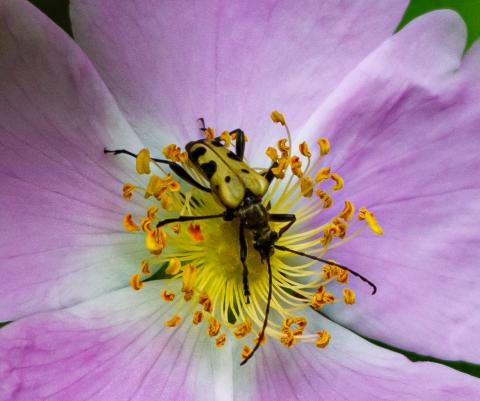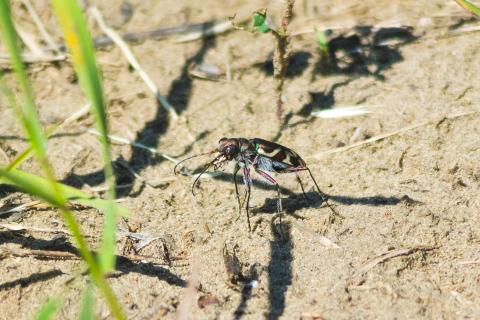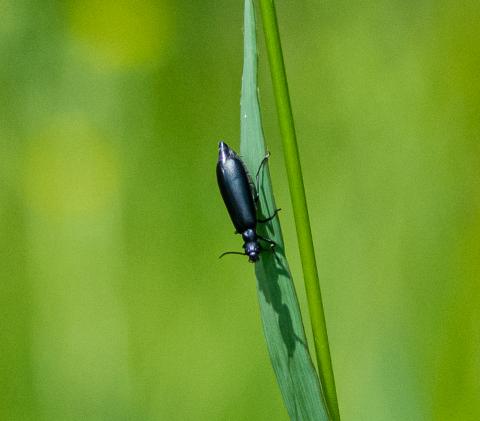Nick Carter, Marketing and Communications Volunteer
Beetles are some of the most diverse of all animal orders. Almost half a million beetle species have been described so far, and the total number out there might be double that or more. These insects live all over the world, and different species feed on plants, fungi, and other invertebrate animals. While nowhere near as diverse as in tropical regions, the beetles of Alberta are still worth getting to know and can be found in just about any habitat throughout the province.
First of all, it’s good to know how to tell beetles apart from other multi-legged critters. Despite some wacky display features present in some species, beetles follow the typical insect formula of head with antennae, a six-legged thorax with a set of wings, and an abdomen at the back end. Most insects typically have two sets of wings, and in beetles the forewings are entirely hardened into protective structures called elytra that, when closed, form a kind of “shell” that closes down the middle of the topside. The hindwings, in turn, are for flying. The mouthparts of beetles are shaped into chewing mandibles that often open and close horizontally. Some can be pretty powerful and deliver a painful bite, so make sure to handle beetles with care.
Throughout Alberta you can look just about anywhere and find some kind of beetle. Perhaps the most beloved and easy to recognize are the Coccinellidae, better known as the ladybugs. Despite the name they aren’t “true bugs” but legitimate beetles. Beloved by gardeners for their aphid-eating habits, ladybugs are famous for their classic red with black spots colouration, though some species can be yellow or brown and have white spots or dark stripes. The common seven-spot ladybug is an introduced species from Europe, but Alberta has many native ladybugs- the two-spotted ladybug is a good example. This species tends to hibernate in people’s houses, so check your window panes for it during the winter.

Ladybugs are related to some very different-looking beetle groups you can find here, such as the long-snouted weevils and the longhorn beetles. The latter are named for their extra-long antennae. Some are small, mild-mannered consumers of flower nectar, though many people out in the Alberta forests have been startled by the large white-spotted sawyer with its tendency to clumsily fly into people out of nowhere.
Another common group are the ground beetles, or carabids as they’re known to scientists. These are beetles that, true to their name, spend a lot of time crawling along on the ground. Some species have large jaws and are obviously predatory. Some ground beetles take a bit of rooting through dead leaves and turning over logs to locate, but their handsome appearance is worth the effort. One species, the sleek, black Pterostichus melanarius, tends to be found crawling along suburban sidewalks. It’s another introduced species, but still serves as a good introduction to the diverse world of ground beetles.
Closely related to the ground beetles are the lean and mean tiger beetles. Not only do these neat insects often have a swirling striped pattern on their backs, but their predatory lifestyle also makes their name well earned. Tiger beetles have long legs they use to dash across the ground at high speeds as well as big bulbous eyes and a large set of jaws, all of which are used to find and capture prey. They prefer sandy places like dunes and riverbanks, and come out from their burrows to hunt on warm sunny days. Unlike some of the more ponderous beetle species, tiger beetles are fast and exciting, and a joy to watch for any naturalist.

On the opposite end of the habitat spectrum from tiger beetles are the dytiscids, better known as the predaceous diving beetles. Shaped like little pumpkin seeds with attitude, these swimming insects spend much of their life in the water hunting other aquatic invertebrates. Not just the adults either, but the fully-aquatic larva form, known as a ‘water tiger’ in some species, are equally as ferocious. While the larvae have gills, adults get their oxygen from air bubbles they capture at the surface and hold underneath the elytra like little scuba tanks. Adults moving to new bodies of water will occasionally land on the dry ground, where their swimming-adapted legs do them no favours as they clumsily move along. They’ll sometimes land on the surface of lakeside cars as well, as the shiny, reflective metal of the vehicle looks to them like the calm surface of a pond.
Predaceous diving beetles may be the terror of the aquatic insect world, but they’re not the only water-loving beetles. Whirligig beetles with their unique divided eyes zip around on the water’s surface while water scavenger beetles handle the dead plant cleanup down at the bottom.

Then there are the scarabs, an amazingly diverse beetle family encompassing things like June beetles, dung beetles, and all manner of huge, wild-looking species from around the world like Hercules beetles and rhinoceros beetles. Scarabs have stout bodies and are often brightly-coloured with a variety of patterns and metallic shades. The antennae of scarabs are unique among beetles and can be fanned-out at the tip, making them look like opened book pages. One of Alberta’s largest scarabs is the ten-lined June beetle, which lives in sandy areas in the southern grasslands.
We could go on forever about the overwhelming diversity of beetles in Alberta- this is just a sample of it. There are also click beetles, blister beetles, metallic wood-boring beetles, and so many others out there. For an easy place to go where you’re guaranteed to see some beetles, drop in at RAM’s famous Bug Gallery where you can get an in-person sample of these insects both from here and around the world. There’s no better place to become a beetles fan.
